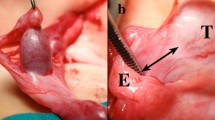Summary
The position of the testis, the relationship between the epididymis and the testis, as well as the development and regression of the gubernaculum were investigated in 18 testicles of children from the 26th week of pregnancy until a few weeks after birth. The most important role in descensus testiculorum is ascribed to the differentiation of the epididymis and the ductus deferens. It is androgen dependent. The testis descends in the processus vaginalis, being attached to its dorsal wall.
Similar content being viewed by others
References
Backhouse, K.M.: The gubernaculum testis Hunteri: Testicular descent and maldescent. Ann. Roy. Coll. Surg. Engl. 35, 15 (1964)
Crelin, E.S.: Functional anatomy of the newborn. New Haven and London: Yale University Press 1973
Galluzzi, W., Possenti, B., Salomone, P.: Aperçus sur l'anatomie évolutive du testicule humain du cinquième mois de la vie intra-utérine jusqu'à la fin du développement foetal. Bull. Aass. Anat. 87, 1028–1046 (1955)
Gier, H.T., Marion, G.B.: Development of mammalian testis. The testis I (Johnson, A.D., Gomes, W.R., and Vandemark, N.L., eds.) New York and London: Academic Press 1970
Had ziselimović, F., Herzog, B.: The meaning of the Leydig cells in relation to the etiology of cryptorchidism. J. Pediat. Surg. 11, 1–8 (1976)
Had ziselimović, F., Herzog, B., Krušlin, E.: The morphological background of estrogen-induced cryptorchidism in the mouse. Fol. Anat. Jugos. VIII, (1978), in press
Holstein, A.F.: Morphologische Studien am Nebenhoden des Menschen. Stuttgart: Georg Thieme Verlag 1969
Hunter, J.: Observations on the state of the testis in the foetus, and on the hernia congenita (William Hunter ed.) Medical Commentaries 1 (1792)
Jost, A.: Hormonal factors in the sex differentiation of the mammalian foetus. Phil. Trans. Roy. Soc. Lond. B. 259, 119–130 (1970)
Netter, F.: Reproductive system Vol. 2. CIBA, New Jersey, 1954
Kopsch, Fr.: Rauber-Kopsch, Lehrbuch und Atlas der Anatomie des Menschen. Stuttgart: Georg Thieme Verlag 1955
Scorer, G.C.: The descent of the testis. Scientific foundations of Pediatrics. (David, A.J. and Dobbing, J., eds.) London: William Heinemann Medical Books Ltd. 1974
Schapiro, B.: Ist der Kryptorchismus chirurgisch oder hormonell zu behandeln? Dtsch. med. Wschr. 38, 38–39 (1931)
Starck, D.: Embryologie. Stuttgart: Georg Thieme Verlag 1965
Sestut, L.: Traité d'anatomie humaine. Appareil uro-génital péritoine. Paris: Gaston Doin & Cie 1931
Toldt, C.: Langer-Toldt, Lehrbuch der systematischen und topographischen Anatomie. Wien und Leipzig: Wilhelm Braumüller 1897
Waldeyer, A.: Anatomie des Menschen. I. Teil. Berlin: Walter de Gruyter & Co 1962
Wensing, C.J.G.: Testicular descent in some domestic mammals. I. Anatomical aspects of testicular descent. Proc. Kon.-Akad. Wetensch. C 71, 4, 423–434 (1968)
Author information
Authors and Affiliations
Rights and permissions
About this article
Cite this article
Hadžiselimović, F., Krušlin, E. The role of the epididymis in descensus testis and the topographical relationship between the testis and epididymis from the sixth month of pregnancy until immediately after birth. Anat Embryol 155, 191–196 (1979). https://doi.org/10.1007/BF00305751
Accepted:
Issue Date:
DOI: https://doi.org/10.1007/BF00305751




